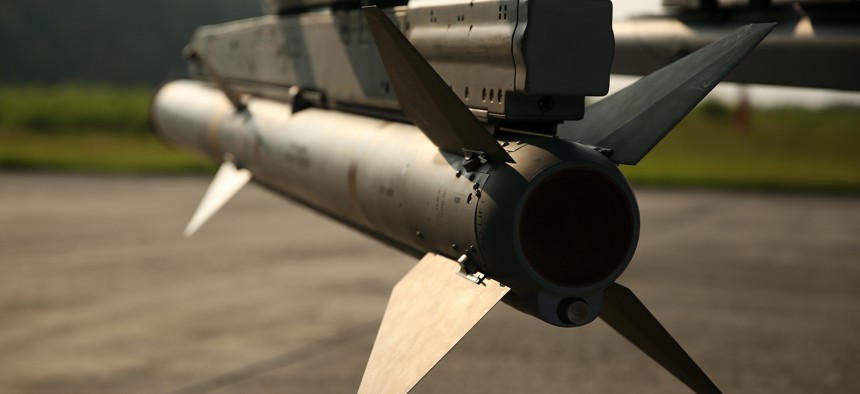
In this 2014 photo, an AIM-120A advanced medium-range air-to-air missile secured aboard an AV-8B Harrier. U.S. Marine Corps / Sgt. T. T. Parish
Ukraine could get '5th-gen' AMRAAM weapons in 3 years
Raytheon completed the first flight test of a new variation of the air-to-air missile in June.
Ukraine will receive a new variant of the Advanced Medium Range Air-to-Air Missile in three to five years, according to weapons-builder Raytheon Technologies.
Ukraine has used older variants of the highly effective missile, carried on a NASAMS air defense system, to defend against Russian drones and missiles. Raytheon is ramping up to essentially double its production of the missile as weapon stockpiles have diminished over the course of Russia’s invasion of Ukraine.
Raytheon completed its first flight test in June of the latest variant of the missile, called AIM-120C-8, Paul Ferraro, president of Air Power at Raytheon, told reporters Thursday. The missile was fired from an F-15C Eagle at Eglin Air Force Base.
The next-gen AMRAAMs are “wildly different, both hardware-wise and software-wise,” than the current missile, Ferraro said.
“I can tell you that the capabilities that are in this missile and have been exercised and tested in the flight test program show outstanding ability to perform its mission in the most stressing environments that we understand will be faced both today and in the future, and it also lends itself to…continual software based upgrades to keep pace with any emerging threats,” Ferraro said.
The company recently finished redesigning the missile—upgrading multiple circuit cards and advanced processors in the guidance section of the missile—an effort called the “Form, Fit, Function refresh,” or F3R. The international variant of the missile, AIM-120C-8, and the domestic variant, AIM-120D-3, were both part of F3R.
Raytheon received a $1.15 billion contract in June to produce the next lot of AIM-120 missiles for international allies and partners, including Ukraine.
The new international variant “will largely largely replace that inventory that's being depleted as they send those to Ukraine,” Ferraro said.
Due to dwindling stockpiles, Raytheon is “in the process of continuing to ramp up our production on D-3 and our C-8s. We've received contracts for more quantities of AMRAAMs in our last couple of lots of AMRAAMs than we've ever received in the history of the program,” Ferraro said.
The current version of the missile has a “90% plus” success rate in Ukraine, Ferraro said.
“You think of all the incoming cruise missiles, drones, and threats that have been faced in Ukraine, AMRAAM-armed NASAMS have proven well in excess of 90% effective at shooting those down, and that's with assets that have already been made available—nowhere near the capability that is available in D-3 and C-8,” he said.
Typically, Raytheon has produced between 500 and 800 rounds a year. But now they are increasing their output to roughly 1,200 rounds, Ferraro said.
“With the demand both domestically and internationally, we expect to be asked to build at our maximum capacity for the foreseeable future,” Ferraro said.
The company has already finished testing the new domestic AMRAAM variant, D-3, which is an “absolutely outstanding capability…it's truly a fifth generation both hardware-wise and software-wise,” Ferraro said.
The D-3 has completed flight testing and while the company doesn’t know how many more flight tests C-8 will need, it will apply lessons learned from the D-3 tests. The first C-8 test met all of its objectives, Ferraro noted.




